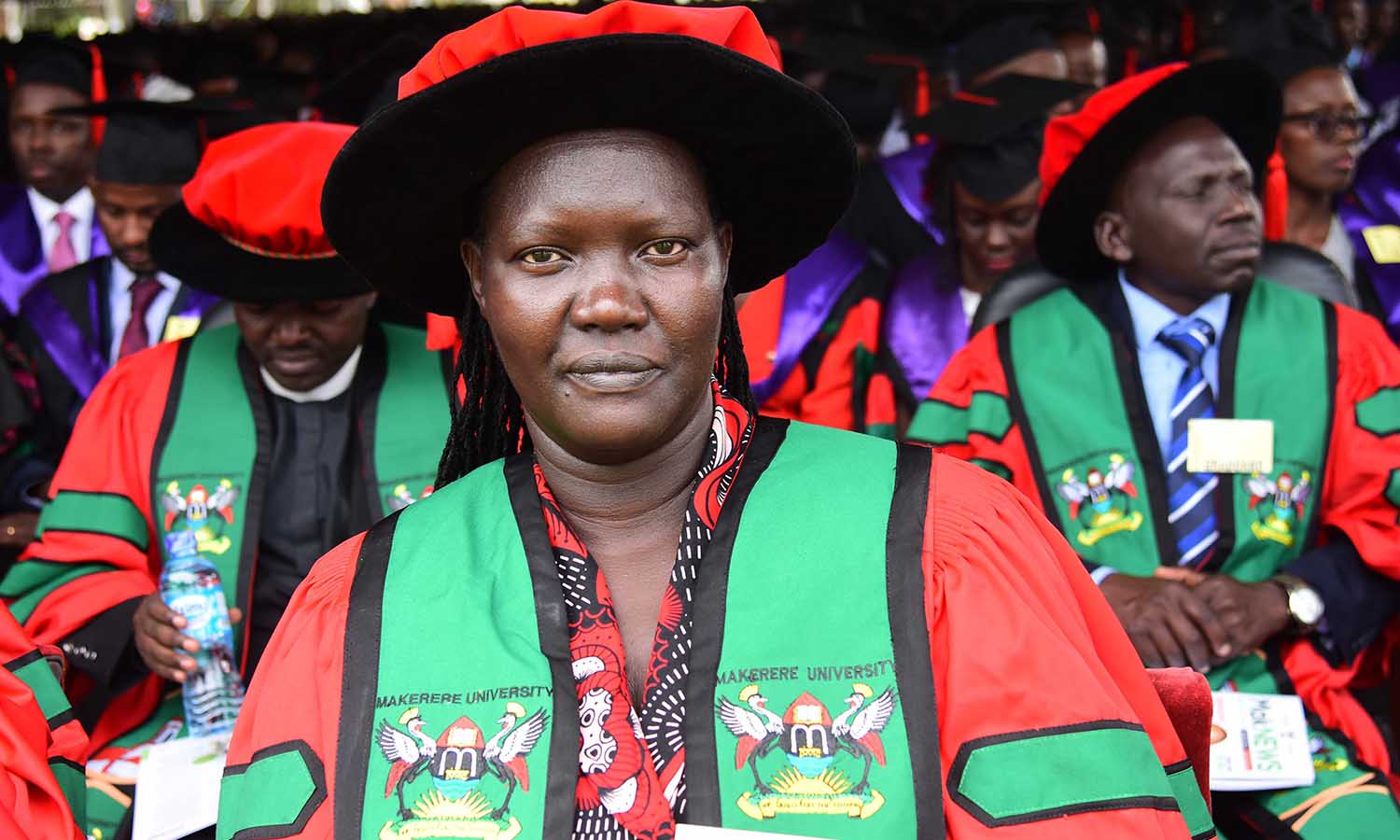Prime
What we sought to find out in our PhDs

Dr Apophia Agiresaasi
What you need to know:
- Most household users were not able to practice both urine diversion and the use of faecal by-products in the gardens. In addition, a higher estimated annual risk of infections comprised Schistosoma species, Ascaris lumbricoides, Entamoeba species and E. coli species in semi-solid faecal by-products.
Dr Apophia Agiresaasi (PhD in Health Sciences)
She investigated the various forms of alcohol use and their predictors among pregnant women in post-conflict northern Uganda and the effect of a communication intervention.
The study also explored women’ attitudes and experiences regarding alcohol use and provided perceptions whereby 23 percent of respondents reported alcohol use (any amount) in current pregnancy.
About 30 percent of drinkers were bingers, four percent of drinkers were alcohol dependents and eight percent were hazardous alcohol users. Societal norms and values too lured women into drinking during pregnancy.

Dr Susan Atuhairwe
Dr Susan Atuhairwe (PhD in Medicine)
She investigated if task sharing which entails entrusting midwives in the management of second-trimester post-abortion care using misoprostol is equally safe, effective, and acceptable as when offered by physicians.
The results revealed that clinical assessment and treatment of second-trimester incomplete abortion using misoprostol was equally effective, safe, and highly acceptable when provided by midwives compared to physicians.

Dr Silvia Awor
Dr Silvia Awor (PhD in medicine)
She determined the ultrasonography, laboratory and maternal characteristics that predict pre-eclampsia and adverse pregnancy outcomes at St Mary’s Hospital Lacor, northern Uganda.
She found the predictors of preeclampsia were maternal age greater than or equal to 35 years, nulliparity, personal history of preeclampsia, overweight, diastolic hypertension, bilateral end-diastolic notch, leucocytosis and low serum ALP.
The mothers with characteristic weights adding up to greater than or equal 6.0 were at high risk of preeclampsia. She recommends incorporating the screening for preeclampsia into routine prenatal care.

Dr Celestin Banamwana
Dr Celestin Banamwana (PhD in Public Health)
He investigated the utilisation of Ecological sanitation (Ecosan) technology and microbial risks associated with the use of faecal by-products in Burera District, Rwanda.
Ecosan aims to achieve a rational use of human excreta through urine diversion and treatment of faeces, although it is surrounded by excreta disgust and related health risks. He found overall poor utilisation of Ecosan technology in Burera.
Most household users were not able to practice both urine diversion and the use of faecal by-products in the gardens.
In addition, a higher estimated annual risk of infections comprised Schistosoma species, Ascaris lumbricoides, Entamoeba species and E. coli species in semi-solid faecal by-products.

Dr Doris Kwesiga
Dr Doris Kwesiga (PhD in Public Health)
Dr Kwesiga investigated the factors influencing reporting of pregnancy and APOs during population surveys in Uganda, Ethiopia, Ghana, Guinea Bissau and Bangladesh.
Reporting was influenced by methodological challenges including question framing and incorrect definitions but interviewers’ skills like empathy were beneficial.
Community barriers comprised socio-cultural factors encouraging silence, including stigma and fearing witchcraft. Individually, APOs caused negative psychosocial effects like depression.
Nevertheless, some respondents felt better after interviews and many participated hoping for health education.
In conclusion, surveys like DHS have weaknesses. Improving measurement requires precise questions, strengthened interviewer training, embedded counseling and health education. Supportive policies encouraging reporting are critical, alongside sensitizing citizens.

Dr Sarah Bunoti Nantono
Dr Sarah Bunoti Nantono (PhD in Public Health)
She explored knowledge levels among 10 – 14 year olds in Jinja primary schools regarding puberty and children’s sexual and reproductive health rights: their sources of this information, challenges, and opportunities available for proper pubertal management.
Results revealed gaps in children’s pubertal and child rights knowledge; and inaccurate knowledge and skills of teaching about puberty among teachers.

Dr Henry Ddungu
Dr Henry Ddungu (PhD in Medicine)
He explored the experience of optimal use of blood and platelets in supporting patients with blood cancers, given the scarcity of blood products in Uganda yet the high demand among such patients.
The study affirms that the need for blood products among cancer patients was very high, but blood availability was lower than needed. It also revealed there were gaps in doctors’ knowledge basics of blood transfusion.

Dr Francis Kakooza
Dr Francis Kakooza (PhD in Molecular Epidemiology)
Dr Kakooza studied the molecular epidemiology and antimicrobial resistance (AMR) determinants of Neisseria gonorrhoeae (NG) among males presenting with urethritis in Kampala, Uganda.
His work included a review of NG AMR surveillance systems in Africa and setting up a quality-assured surveillance program according to WHO standards.
He also found two distinctive gonococcal lineages with different genotypic profiles, a very high level of diversity and numerous novel strain types.
He recommended genomic AMR surveillance systems in Africa. The research was funded by World Health Organisation and the Infectious Diseases Institute.

Dr Juma Benson Ouma
Dr Juma Benson Ouma (PhD in Immunology)
Dr Ouma investigated the immunological and genetic risk factors associated with cognitive and neurological impairment in severe malaria in Ugandan children.
He observed that increased endothelial activation markers contribute the pathophysiology of severe malaria and is a risk factor for long-term cognitive deficits in survivors.
Among endothelial activation markers, he studied, angiopoietin-2 associated with disease severity, and worse long-term cognition in children with severe malarial anemia and cerebral malaria. He furthermore focused on cognitive sub-domains by evaluating the impact of age at severe malaria exposure on cognitive outcomes over time.
Angiopoietin-2 levels are associated with worse long-term neurocognitive outcomes in multiple domains in children with SM at less-than five years of age and persist beyond five years of age.
This biomarker may be used in translational research to develop adjunctive and also in validation studies to assess the potential of angiopoietin-2 to be a biomarker for risk stratification.

Dr Francis Xavier Kasujja
Dr Francis Xavier Kasujja (PhD in Public Health)
He investigated the effectiveness of type 2 diabetes testing point-of-care testing in eastern Uganda, focusing on Fasting Plasma Glucose (FPG) and Glycated hemoglobin (HBA1c) tests.
It was conducted at Iganga General Hospital, The study revealed that misconceptions about diabetes, reliance on traditional medicine, and inadequate primary care diagnostics lead to delayed diabetes detection, resulting in four distinct diagnostic pathways.
Both FPG and HBA1c showed similar sensitivity and specificity in diabetes screening. However, their effectiveness was reduced in patients with asymptomatic malaria. A cost-effectiveness analysis demonstrated that HBA1c testing was more cost-effective than FPG testing from a societal perspective, with an ICER of $989.06 per additional patient correctly diagnosed.

Dr Rehema Namaganda
Dr Rehema Namaganda (PhD in Social Anthropology)
She studied the meaning of aging and disability in old age. She analyzed the experiences of people that age with, and people that age into disability and how these access and use mobility assistive technology.
Her findings reveal that disability in old age is caused mainly by untreated illnesses, followed by falls.
She observed that while assistive technology could help restore functionality among older persons, their use is based on the social significance, symbolic value and meaning assigned to them.
Older persons may or may not use a certain device, because of the symbol and meaning it conveys to them and the community around them.
The study also revealed that old age and ageing is marked by non-chronological symbols such as historical events and body functionality.
She concludes that appreciating this symbolic value and meaning has great potential in improving programming for older persons in Uganda and similar contexts.
Compiled by Dorothy Nagitta.
Photos by Frank Baguma
Eub Editor: Eva Kyomugisha




